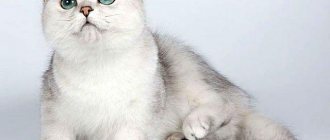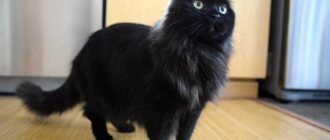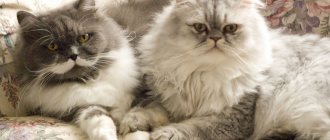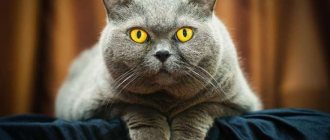The red coat color of cats has long been considered traditional. It is present in almost all registered breeds, has a stable genetic transmission mechanism from generation to generation and never causes problems with over-blooming or age-related changes. But even such a stable color has a number of hereditary characteristics on which the appearance of a British cat depends.
Genetics of the red (red) color of the British
The British Shorthair breed allows for approximately 250 different color combinations, with solid colors playing a major role. Ginger cats are not unique here, they are often found in litters and were once even quantitatively ahead of the blue-gray color that is considered traditional for the British.
All the tools of the genotype take part in the process of color formation: chromosomes and genes, alleles, loci and pigmentation.
- The main role in the formation of the red color in the British is played by the pigment pheomelanin - elongated ellipsoidal granules that reflect light in the range of red, yellow and orange shades.
- Genes are a library of hereditary data that is passed on from parents to offspring and continues the chain of ancestral connections ad infinitum.
- Alleles come in different forms that genes can take on. They are located on certain parts of the chromosomes - in the example of red British cats, this is a very important point.
- Locus is the location of a gene (allele) in an ordered list of chromosomal compounds.
Find out in detail about cats with red color.
There are 19 pairs of chromosomes in a cat's set. They store the hereditary instructions, and any deviation from the norm ends in an uncontrolled mutation. British redheads are not subject to this risk, as they are an ancient breed with an established genotype.
Genes and chromosomes that influence the formation of red color are distributed as follows:
- The O (orange) gene is responsible for the production of the red pigment pheomelanin in the British (and not only in them). It has only one permanent locus attached to the X chromosome, which determines the sex of the future kitten.
- The O gene exists in 3 alleles: OO (natural red), Oo (red and black tortoiseshell British), oo (red is blocked and does not cause pheomelanin pigmentation). The final example in practice means only one thing - the cat will be black.
- For ginger cats, there are 3 color combination options: OO, oo and Oo. For red British cats, only 2 options are possible - O and O, since they have one X chromosome.
- According to the laws of genetics, a British cat inherits the orange gene from its mother. Therefore, in a pair with a red mother and a blue-gray father, male kittens will definitely receive the properties of the red gene, and the female cats will be tortoiseshell, cream or blue.
This is interesting! There are many more ginger British cats than cats, because boys receive the color gene only from their mother, and girls inherit the properties of both parents.
All British red coats have a tabby pattern on their coats. It is formed under the influence of the A gene (agouti) and exists in two alleles: dominant A and paired homozygous aa. In the second case, agouti suppresses another important component of the genotype - the T (tabby) gene, which is responsible for the ornamentation on the fur coat.
The unique property of the red color is that aa (not agouti) has no effect on it. Therefore, all red British cats are always tabby.
The L gene is also involved in the formation of red color. Thanks to him, purebred British cats have short and thick hair.
Important! The birth of a red or cream female kitten suggests the presence of a dominant O gene in the genotype of two British parents. Only direct pedigree lines influence the external characteristics of the offspring.
Diseases
Despite a strong immune system, if not properly maintained, a cat may encounter some diseases.
- Obesity. Excess weight appears in conditions of physical inactivity against the background of abundant nutrition, excess consumption of fatty and protein foods. To get rid of fat deposits, you should play with the cat more, let your pet go for walks, and adjust the diet.
- Nail fungus. Timely trimming of nails and constant care for their condition will help prevent the disease.
- Hair loss. Shedding can be triggered by allergies or damage to internal organs.
- Tartar. As a preventative measure, you can periodically give your pet dry food. It is necessary to monitor your cat’s oral hygiene: brush its teeth. If symptoms of tartar appear (bleeding gums, increased salivation, putrid odor from the mouth), the help of a veterinarian will be required. If left untreated, your pet's teeth will begin to fall out.
- Eye irritation. Redness of the proteins indicates the development of an allergic reaction, injury or the appearance of conjunctivitis. For this reason, the cat needs the help of a veterinarian - a specialist will prescribe eye drops.
- Gastrointestinal disorders. It is necessary to monitor the quality of food and the condition of the cat. If your pet is lethargic, you should pay attention to his stool. There may be blood clots in the feces, which indicate the development of internal bleeding. Various parasites can enter a cat's body along with food.
Among the inherited diseases, hypertrophic cardiomyopathy stands out. In such a situation, it is recommended to sterilize the cat to reduce the risk of developing this pathology in kittens. Elderly individuals may develop urolithiasis, plague, and calcivirosis.
Most diseases can be cured with medication or surgery.
British red color standard
There is a uniform standard of coat quality and color for all British Shorthairs. Felinologists are trying to preserve this indigenous breed unchanged. Therefore, experts carefully monitor all experiments aimed at diversifying the colors of cats.
- The coat is short, elastic, silky. In red color, stiffer guard hair is allowed, which should not fit tightly to the body.
- Bright red British cats have an undercoat of the same shade as the main coat. Bald spots of a different color and uneven coloring are not allowed.
- The chin, tip of the tail and a small area on the belly may be slightly lighter than the base coat shade. In pedigree breeding, such a transformation is not welcomed, but at exhibitions experts are loyal to it.
Additional requirements apply to eye color, paw pads and nose:
- The pupil is always colored in honey, orange or copper tones.
- The color of the skin of the nose and pads is darker than the base color - brick, terracotta or bleached brown.
In red British cats, the tabby pattern will always be contrasting. There should be clear lines on the chest and neck. The same pattern starts from the corners of the eyes and covers the cheeks. On the paws and tail there are distinguishable encircling rings of the primary color.
Acceptable variations and deviations in British Reds
All colors containing red in the British are divided into several categories.
The first includes standard solid colors (solid). In this case, the wool will be dyed evenly along its entire length. The British acquired this color as a result of crossing with the Persian longhaired breed.
In the future, such inter-tribal unions were prohibited due to the increase in hair length, but the color was fixed and consistently transmitted with proper breeding.
The next category is red smoky, which is formed when the pigment is unevenly distributed throughout the hair. The root part remains light, only 4/5 of the length is colored.
The fur of red British cats seems evenly colored, but when moving, lighter areas of the hair are revealed, resulting in the effect of a shimmer of shades.
Another color option is silver-red, shaded. Here the wool is pigmented to 1/3 of its length, and 2/3 remains bleached. At the same time, the nose, eyes and lips of shaded red British kittens have a contrasting dark edging.
The next variety of red is the red chinchilla. The pigment appears only at the tip of the hair (1/8 of the length), and the rest of the hair is not dyed. The term “cameo” is used for British people with this coat color.
The acromelanic color-point (red-point) has a lighter shade of body, in contrast to the mask on the face, the tips of the ears, the ends of the paws and the tail.
British Red kittens can be born bicolor or particolor. This is a combination of white and red colors, which is considered traditional for many cat breeds. They differ only in the amount of white wool.
- from 30 to 50% white - bicolors;
- from 50 to 90% white - particolors;
The rarest combinations for cats of the British breed:
- Harlequins are 90% white and 10% red.
- Vans - maximum white color. Only the tail and a few markings on the head near the ears remain in red.
Briefly about the British
The British cat breed was first introduced in the second half of the 19th century, although images of animals visually very similar to the British can be found in manuscript books from the 7th and 8th centuries. Officially, breed standards were approved much later, in 1980. The breed is recognized by all world phenological organizations.
British cats were popular back in the 19th century
The British are characterized by a large, massive and muscular build. Males weigh on average about 6–8 kg, but some individuals reach 10 kg. Females are more graceful and smaller. The body is powerful, slightly squat, well molded, with a wide chest and massive shoulders, strong, slightly short legs.
A large round head with a wide skull, set on a strongly developed and short neck. The cheeks are convex and thick, the chin is strong and firm. Short ears with slightly rounded tips are set wide apart. Not too long, but quite proportionate, the tail thickened at the base, slightly tapering to a rounded tip.
All British cats have a massive, large build.
The British breed is famous for its short, plush and very thick coat with a high-quality dense undercoat. It is extremely pleasant to the touch, silky and tender.
Cinnamon - red tortoiseshell color in the British
Tortoiseshell coloring is common in British cats. It is formed by a harmonious combination of evenly colored red and black hairs. But in the case of ginger cats, cinnamon (cinnamon) replaces black and goes with any shade of red.
There are no strict rules regarding the size and number of spots in the British tortoiseshell cat color variety. It is genetically impossible to predict how they will lie on the wool, and therefore any arrangement is allowed.
In tri-colored British tortoiseshell cats, white is added to the two standard spot colors (red-black or cinnamon). Such animals are sometimes called patchwork animals, although this definition does not accurately describe their appearance.
Usually female kittens are born with a tortoiseshell color. However, nature sometimes experiments unsuccessfully, and cats become the owners of an additional chromosome (XXY). In this case, they are also born “turtles” and, most likely, will be infertile.
Breeding
Puberty in British cats occurs at the age of 10 months. The pet's increased excitability indicates its readiness to reproduce: the animal often screams, begins to scratch furniture, and may bite. During this period, the owner is faced with a difficult choice: to sterilize the pet or give him the opportunity to continue his family. In some cases, sedatives in the form of drops help. Sedatives can be given to a 1-year-old pet 7-14 days before mating season.
The first copulation should take place no earlier than the pet turns 1.5 years old. Until this time, the cat’s body continues to develop. Mating before reaching 1.5 years of age can lead to difficult pregnancy and childbirth in females, the birth of weak kittens, and in males to erectile dysfunction.
Mating is carried out on average for 2-3 years of a pet’s life:
- the cat must be brought to the territory of a domestic cat and given time to adapt to new conditions within 3-4 days;
- after getting used to it, the cat will let the cat come to her and give him the opportunity to sniff her;
- It is more effective to arrange mating 2-3 days after the start of estrus.
The pet's potential partner must be vaccinated and healthy. It is not recommended to allow cats near young cats, as they can harm them. It is important to remember that unneutered cats actively mark their territory. Because of this feature, the apartment begins to smell unpleasantly of urine.
You can sterilize your pet no earlier than 10 months. During this period, the reproductive system is fully formed, and the presence of sex hormones in the blood is no longer required. Castration or sterilization should be carried out before the first mating so that the animal does not succumb to instinct, otherwise the cat will continue to scream and go for walks to look for a potential sexual partner.
Rules for caring for a British pet's coat
The rules for caring for the coat of red British cats do not differ from cats of this breed with other colors.
- The animal is combed 1-2 times a week to remove excess hair. Both standard combs and special mittens are suitable for this. A thick undercoat will require regular grooming. You should not let it fall into a tight felt boot, which prevents the skin from breathing freely.
- During active molting, treatment is repeated daily, and sometimes several times a day.
- Almost all cats do not like water, so thorough combing and treating the coat with a damp cloth is the best hygiene procedure for a red British cat.
Coat quality is an objective indicator of a cat's health. As soon as it loses its shine, begins to roll into untidy icicles or falls out intensively, it means your pet has health problems.
This is interesting! To maintain a high-quality red color, felinologists recommend introducing seafood into the cat’s menu. They contain a lot of iodine, which makes the color rich.
The right approach to feeding
Having given preference to natural nutrition, it is necessary to include raw lean meat in the animal’s diet.
An important aspect of keeping British cats at home is a healthy diet. Tawny British kittens up to six months of age should receive food at least 5 times a day. Older pets are fed twice a day: morning and evening. Description of the basic rules of proper nutrition for the British:
- fresh food;
- food at room temperature;
- feeding at the same time;
- removing leftover food from the bowl;
- the presence of a cup of clean water next to the food plate.
As for the products for feeding the British, it is allowed to feed the pet with store-bought food, but many owners prefer to pamper their cats with natural food. An unbalanced diet can harm the animal. The menu of British cats includes lean raw meat. The product is pre-frozen for 2 days to get rid of pathogenic microorganisms. Preference is given to beef, which is cut into small cubes along with films and veins. It is permissible to give such meat daily. This food improves chewing reflexes and protects teeth from the formation of tartar deposits.
It is allowed to include turkey, chicken, and rabbit in food. The British also love offal, especially liver. Boiled fish and fermented milk products are allowed in limited quantities. This food will provide the body with the required nutrients and vitamins. It is useful to add porridge, eggs and fresh vegetables to the menu.
Pros and cons of British redheads
All British cats, regardless of coat color, are distinguished by their independence and even a certain amount of unhealthy selfishness. At home, they prefer privacy and communicate with the owners only when they themselves want to. The expression “a cat walks on its own” applies to the British breed in the best possible way.
It has been noticed that ginger cats are more loyal to family members than their blue-gray or black “relatives”.
Interestingly, homebodies and introverted people rarely choose Britons as pets. This cat is ideal for those who work a lot and are often away from home.
The animal easily tolerates loneliness, so after enjoying the solitude to the fullest, in the evening the Briton kindly greets the owner and even sits on his lap with pleasure. And this is enough to make your vacation cozy and comfortable - a good home, a strong family and a ginger cat that greets the owner with a quiet purr.
Subtleties of content: how to deal with the red-haired beast?
In order for the furniture to remain intact, it is recommended to equip the cat with her resting place, and install a scratching post there.
Having decided to get a British kitten, it is important to prepare. You need to decide on a place for your pet to sleep and rest, purchase a cat house or bed. Decide where feeding and toileting will take place. Accordingly, you should buy bowls for food and water, and a tray. It is worth considering carrying. You will need it for trips and trips to the vet. To keep the household things in place, you need to purchase toys. Small kittens will especially need them. A scratching post will ensure the safety of the furniture. A brush with a massage effect, which is used to comb your pet, will help prevent hair from appearing on carpets.
We recommend reading: American Toy Fox Terrier: description of the breed, care, photos, nutrition
British cats do not require special care, but it is important for the owner to remember the following rules:
- Wash your Briton's eyes every day with boiled water or tea leaves.
- Treat the ears with a cotton swab dipped in warm water. Carry out the procedure twice a week.
- Brush the cat with a special brush once every 7 days.
- Trim nails monthly.
If you follow these nuances, the pet will grow up healthy and delight its owners.
Tabby (tabby)
Tabby is one of the most popular cats among Scots. The color of Scottish tabby cats is distinguished by the presence of a pattern in a certain area on the coat. The pattern on the wool can be anything. A distinctive feature is considered to be a pattern in the form of the letter M on the forehead.
Tabby color depending on the type of pattern:
- striped like a tiger (has vertical stripes on the sides);
- spotted;
- marble (pattern of chaotic spots and stripes of different sizes).
And depending on the color combinations to the following:
- golden tabbies;
- cream tabby;
- blue;
- black marble;
- marble on silver
- silvery blue (gray tint);
- silver (silver color);
- cameo.
Tags
Dog Breeds Cat Breeds Rodent Breeds Dog Breeds Cat Breeds Rodent Breeds Dog Breeds Cat Breeds Rodent Breeds Dog Breeds Cats Cats Cats Cats Fold Cat Scottish Fold Cats Already Shorthair Cat FamousBritish Cat Got White Cat Sambar Cat Made for Cats Grooming Cats Feeding Cats Neutering Cats for Cats Cats Life for Cats Scottish fold cat
dogsshorthairtimesreadcontentshistory
Hereditary diseases
The British Shorthair cat has strong immunity. In general their health is good. However, there is information about a tendency to hereditary diseases.
Polycystic kidney disease
This is a genetic kidney disease. Characterized by the formation of cysts on the surface of organs. The first symptoms may appear at 2 years of age. The peak of the disease falls at 7 years of age.
Symptoms:
- lethargy;
- frequent urination;
- strong thirst;
- lack of appetite;
- weight loss;
- nausea and vomiting.
There is no direct treatment for polycystic disease. Medications are prescribed that slow down the growth of cysts and remove associated symptoms.
Important!
If the kitten's parents are healthy and do not have such abnormalities, then the kitten will be healthy.
Cardiomyopathy
The disease consists of an increase in the volume of the heart, thickening of the walls of the heart, or hardening of the heart muscle. Such reasons interfere with normal heart rhythm and lead to a bunch of problems.
For prevention, cats from 5-6 years of age undergo an annual heart ultrasound and collect information about the pet’s condition. If a pet has not acquired the disease before the age of 8, it is not in danger.
List of symptoms:
- lethargy and apathy;
- difficulty breathing and asthma attacks;
- constant shortness of breath;
- low body temperature;
- fainting.
There is no treatment. The veterinarian prescribes a number of medications that significantly alleviate the pet’s situation and prolong its life.











